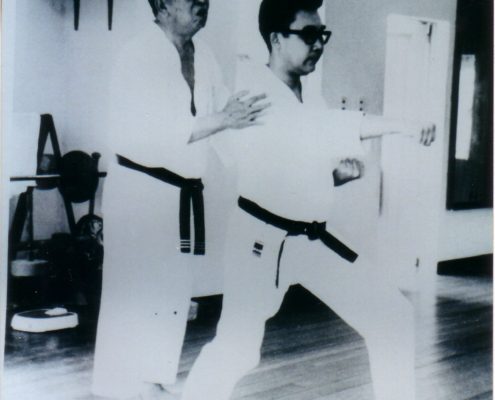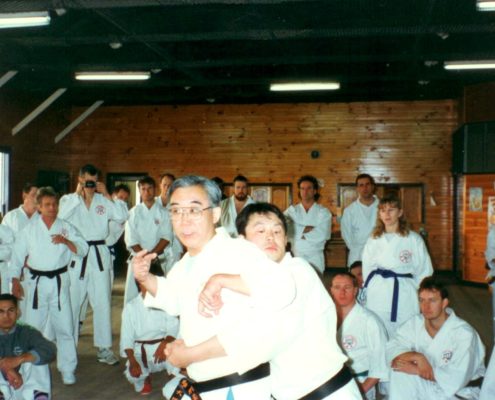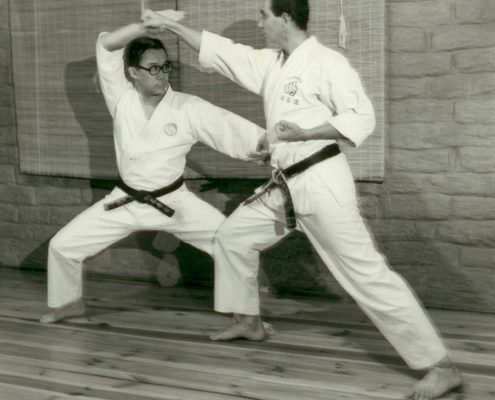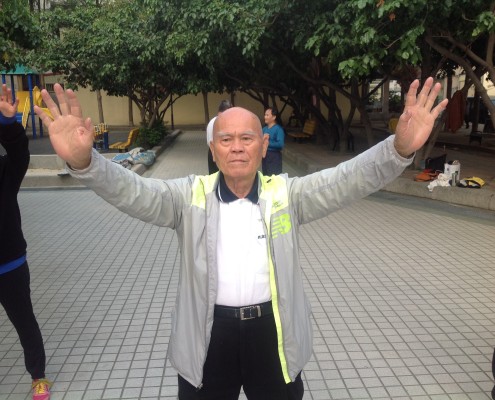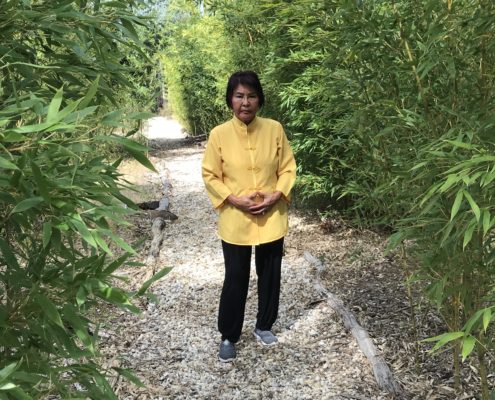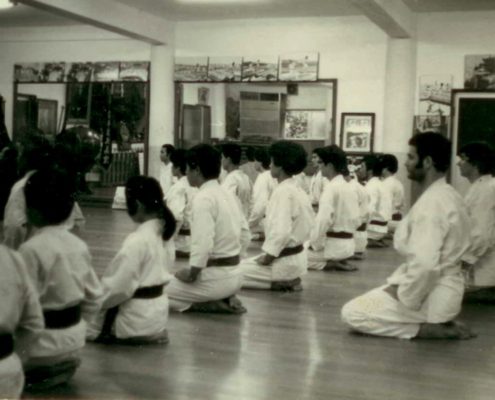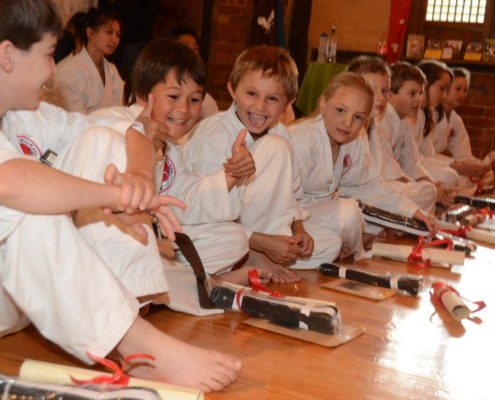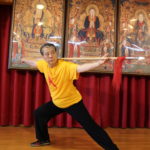An Interview With Sensei Tadahiko Ohtsuka. Part 1
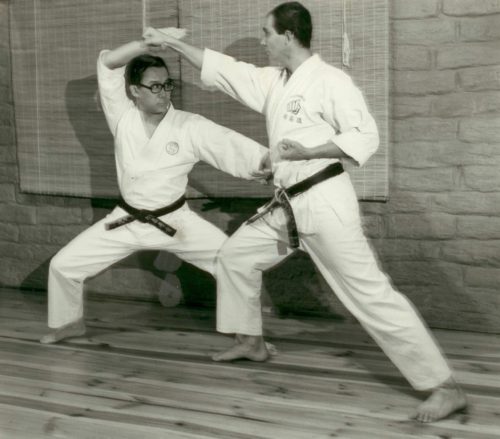
Ohtsuka Sensei demonstrating bunkai.
Ohtsuka Tadahiko was born in Tokyo on June 10th 1940. He began studying Goju Ryu Karate-do in 1955 under the direction of Master Sosui Ichikawa, a senior student of the legendary Kanki Izumikawa, from the Chojun Miyagi to Seko Higa line. Ohtsuka Sensei attained his 5th Dan ranking as soon as 1965 and also graduated in law from Meiji University. Two years later a meeting with Chinese Tai Chi Master Yang Ming Shih had a major impact on his life, resulting in his development of a passion for Tai Chi Chuan. Then in 1968 he discovered the Chinese Internal Kung Fu systems of Hsing I and Ba Gua through Master Wang Shu Chin from Taiwan who came to stay several years in Japan. Concurrently he studied technique for thee maximisation of striking power with Shorin Ryu Master Yochuku Higa of Okinawa.
Ohtsuka Sensei founded his own association in 1970, GOJU KENSHA. He is one of the greatest contemporary Sensei, he continually taught both Karate and Tai Chi, and at appropriate stages, integrated his broad knowledge of Chinese Internal Kung Fu into his teaching. As well as being a councillor for the central Tokyo municipality of Chuo-ku for over 30 years, he travelled frequently to Okinawa, Taiwan and China to further his research into the inner (soft) and outer (hard) styles which evolved into modern day Karate. He saw his research as progressive, reversing the preoccupation with the narrow skilled tournament technique that is now prevalent, and taking the Martial Arts back to the versatile, vital techniques, which established their original reputation.
James Sumarac: Sensei, has the knowledge of Chinese arts you have gained over the past 45 years changed your Karate?
Ohtsuka Sensei: Yes, in my association, one cannot become a Karate Instructor if they have not studied Tai Chi. The opposite is not true. I have many elderly students who practise Tai Chi without knowledge of Karate. This said, I don’t think there is a Tai Chi Master in China who hasn’t studied in an external system in their youth. So the balloon that went very high goes down in a slow way.
My sincere belief is that Goju Kensha students who incorporate Tai Chi with their Karate will become more powerful as their age increases and slowly decrease Karate training and increase Tai Chi. This means they can train all their lives. Karate is more difficult for some women, children and elderly people but all can practise Tai Chi. Karate aims at the outer enemy, whereas Tai Chi concentrates on the inner enemy. The two go in perfect harmony. I believe Chinese Martial Arts to be the Father of Karate and Okinawan Martial Arts the Mother…
I’ll elaborate on the enemies I spoke of, Karate is the insurance from an outside enemy, but Tai Chi guards against the inner enemy that is illness and stresses.
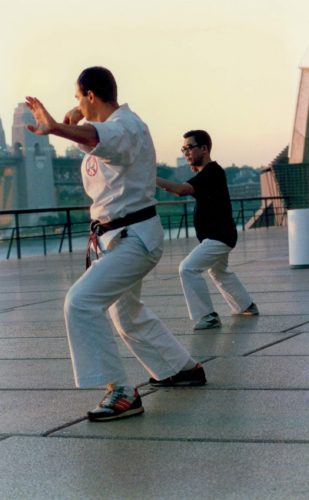
Ohtsuka Sensei and James Sumarac practicing Tai Chi in Sydney.
J.S: Does your Dojo spend a lot of time on Kata Sensei?
O.T: Yes, the Kata in the Goju Ryu system are progressive, with each successive form building on the earlier. In this method a student still practises, maintains and sharpens their skills whilst learning new skills. I teach the Goju Ryu system quickly, in my Dojo Sandans should have mastered the Goju Ryu Kata. After many years of practising the Kata and bunkai together a student will become attuned with Kata. For me, Karate is nothing without Kata. I believe Kata to be the living soul of Karate-do.
J.S: You also lay importance on bunkai (combat applications), Sensei?
O.T: Of course, it was from the bunkai that Kata was born. The Kata then becomes a reference work for the bunkai when you have no partner to train with. It is important to live the bunkai when you perform Kata. Strive for perfection of movement and form, without straining or overdoing the Kata for show. Kata must be natural. Yes, we spend a lot of time on bunkai and sebaki sets, these teach us to evade, apply pressure and counter in one movement with kime(focus). We train in Karate to rid ourselves of an attacker in one motion, effectiveness with least amount of effort. This is difficult, but it is real Karate.
J.S: Mawashi uke (roundhouse block) is used in all Goju Kata, is it useful for Kumite?
O.T: In the Dojo and competition there are rules. You must not attack the eyes. So that is why you can’t use it, one of the first principles of Martial combat is to attack your opponent’s eyes straight away. After that anywhere is O.K, but the eyes first, so in an actual self-preservation situation you could use it.
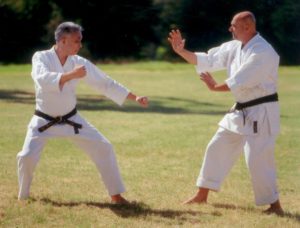
Ohtsuka Sensei and James Sumarac demonstrating different Kamae
J.S: What are the important points for performing Kata Sensei?
O.T: To be able to properly use the combat applications, most people think that if you are able to do the Kata it is from there that the techniques are formed. But in fact it is the other way around. It is from being able to do the techniques that the Kata may be performed properly. Kata is like the wife and techniques the husband; you have the Kata so that you don’t forget the techniques. It makes a lot of sense to practise the applications often. Bunkai can be used 100% for self defence, but only 20% for kumite because of the serious nature of them. Rather than studying a few Kata perfectly I suggest you study a lot more Kata.
J.S: Can you please explain the important points about Kumite Sensei?
O.T: Kumite in Karate is very important. Your training should be shared equally between, basics, Kata and Kumite. In regards to Tournament Kumite, competing once a year is enough, anymore may interfere with your long-term development as a Karate-ka. Lets talk about Jyu Kumite (free sparring). This is like a dialogue, a conversation, and an exchange of words. The more you talk, the better and more confident you may become. What we talked about 10 years ago, I don’t remember, but I remember the books I read 10 years ago. Kata is like a book, Kumite like a conversation. In any particular technique there are five things to think about:
- How to use it as atemi (striking).
- How to use it as gyaku (joint locks and reversals)
- How to use it as nage (throwing).
- How to use it as katame (pinning)
- How to use it as shime (strangulation)
So you have to think about those five possibilities in using your technique. You should also think about distance — how to enter, from the inside or outside. You have to think about whether the person has a long range or short-range weapon. If you research this then you will certainly use technique from Kumite. When practising Kata, the movement has to be correct. First learn the technique perfectly, second is flow and speed, finally the effect.
 Cart
Cart